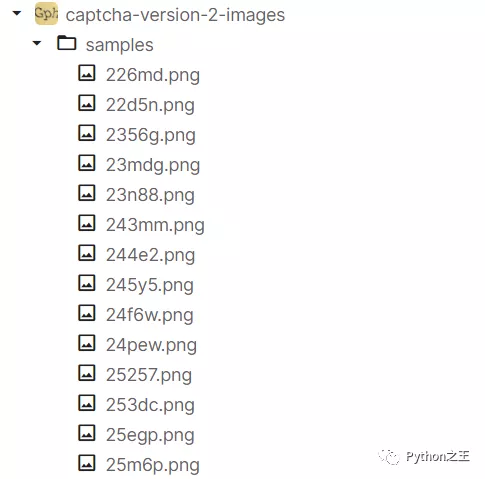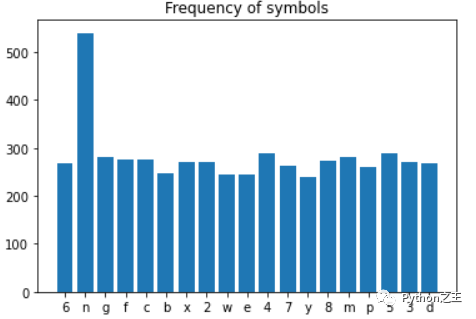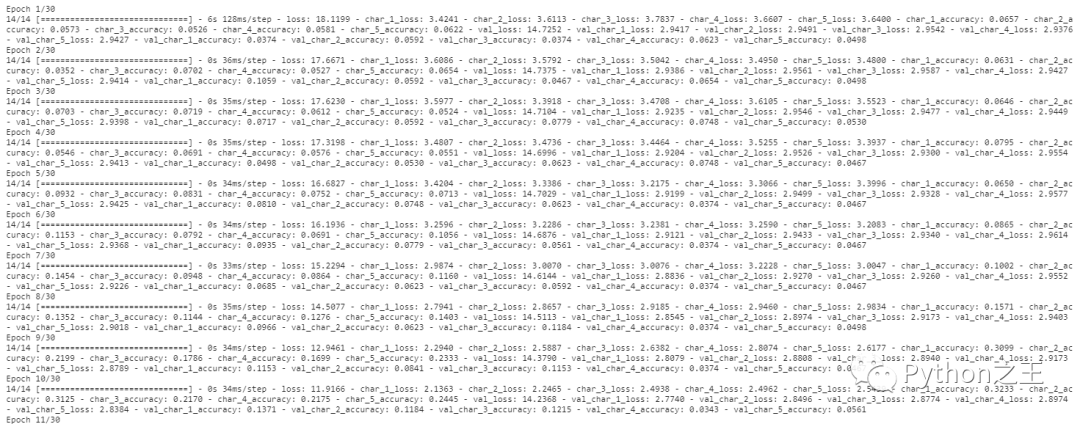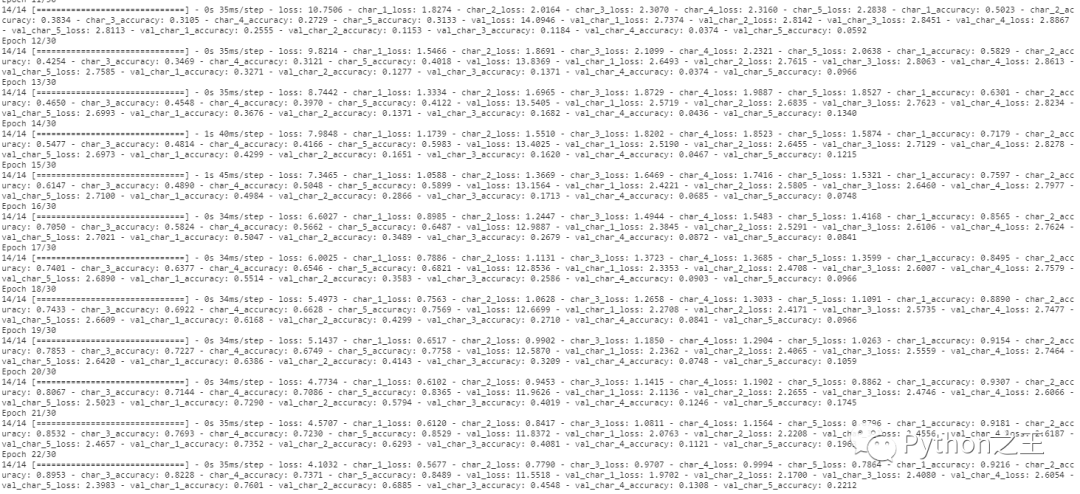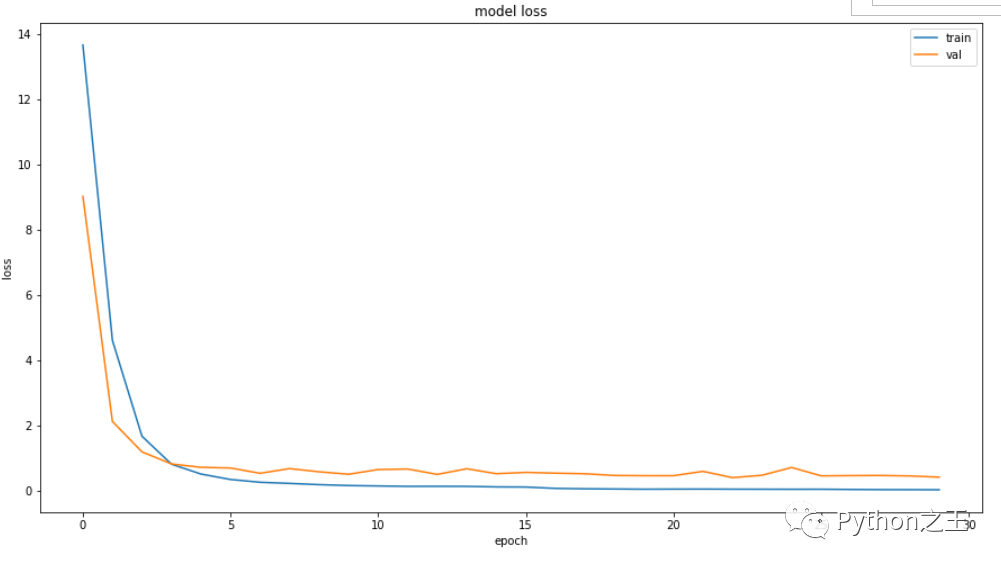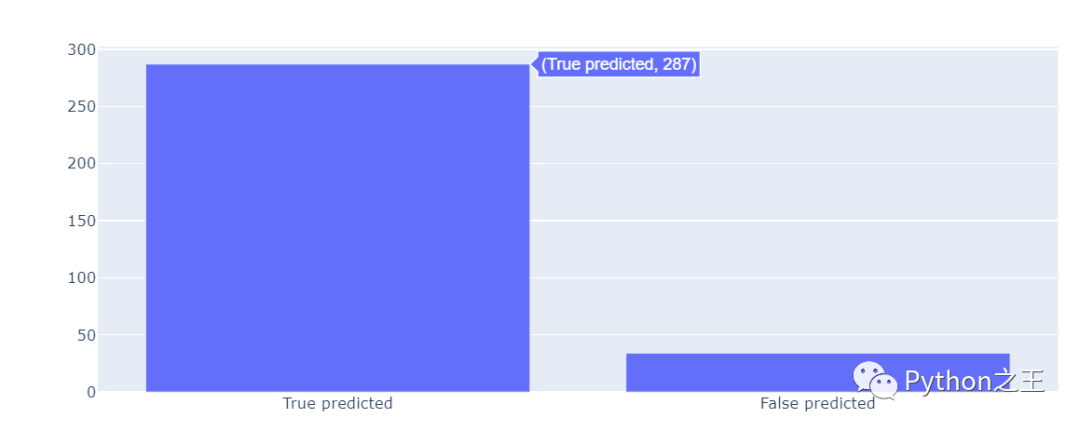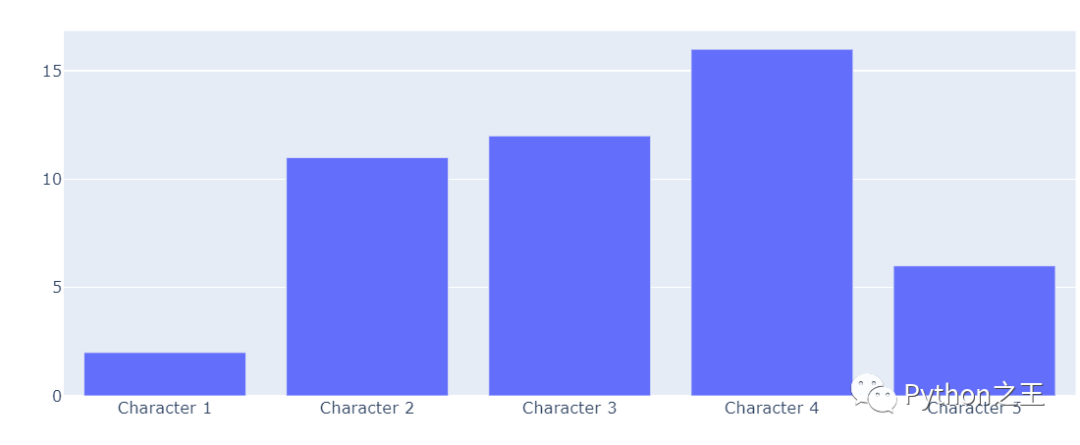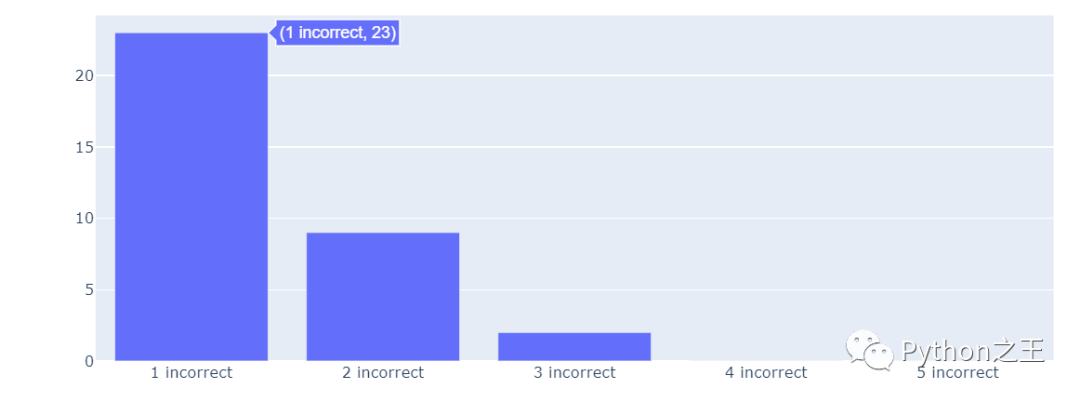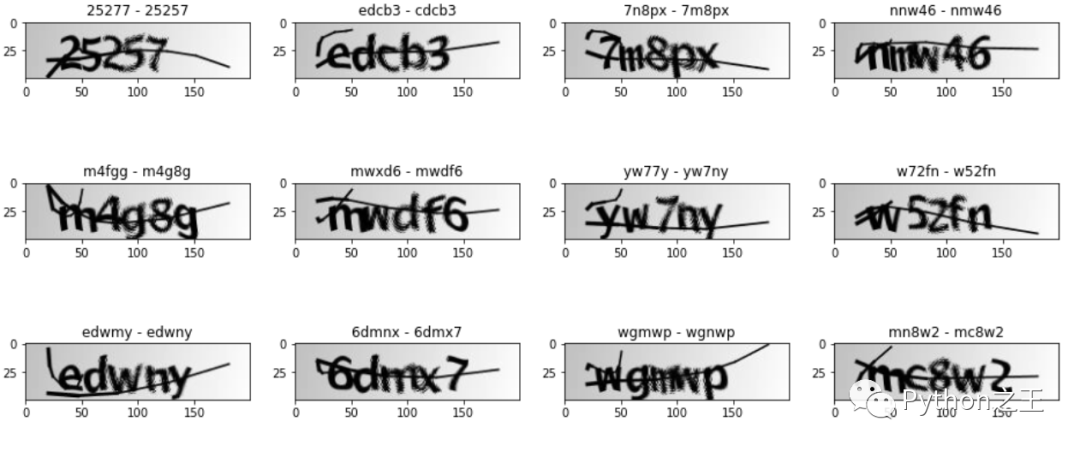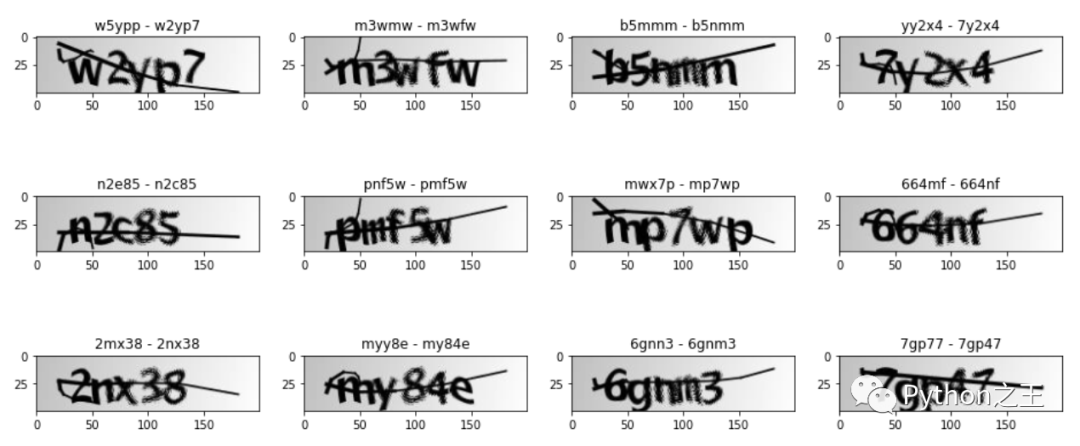验证码是根据随机字符生成一幅图片,然后在图片中加入干扰象素,用户必须手动填入,防止有人利用机器人自动批量注册、灌水、发垃圾广告等等 。
数据集来源:https://www.kaggle.com/fournierp/captcha-version-2-images
图片是5个字母的单词,可以包含数字。这些图像应用了噪声(模糊和一条线)。它们是200 x 50 PNG。我们的任务是尝试制作光学字符识别算法的模型。
在数据集中存在的验证码png图片,对应的标签就是图片的名字。
- import os
- import numpy as np
- import pandas as pd
- import cv2
- import matplotlib.pyplot as plt
- import seaborn as sns
- # imgaug 图片数据增强
- import imgaug.augmenters as iaa
- import tensorflow as tf
- # Conv2D MaxPooling2D Dropout Flatten Dense BN GAP
- from tensorflow.keras.layers import Conv2D, MaxPooling2D, Dropout, Flatten, Dense, Layer, BatchNormalization, GlobalAveragePooling2D
- from tensorflow.keras.optimizers import Adam
- from tensorflow.keras import Model, Input
- from tensorflow.keras.callbacks import EarlyStopping, ReduceLROnPlateau
- # 图片处理器
- from tensorflow.keras.preprocessing.image import ImageDataGenerator
- import plotly.express as px
- import plotly.graph_objects as go
- import plotly.offline as pyo
- pyo.init_notebook_mode()
对数据进行一个简单的分析,统计图像中大约出现了什么样的符号。
- # 数据路径
- DIR = '../input/captcha-version-2-images/samples/samples'
- # 存储验证码的标签
- captcha_list = []
- characters = {}
- for captcha in os.listdir(DIR):
- captcha_list.append(captcha)
- # 每张验证码的captcha_code
- captcha_code = captcha.split(".")[0]
- for i in captcha_code:
- # 遍历captcha_code
- characters[i] = characters.get(i, 0) +1
- symbols = list(characters.keys())
- len_symbols = len(symbols)
- print(f'图像中只使用了{len_symbols}符号')
- plt.bar(*zip(*characters.items()))
- plt.title('Frequency of symbols')
- plt.show()
如何提取图像的数据建立X,y??
- # 如何提取图像 建立 model X 的shape 1070 * 50 * 200 * 1
- # y的shape 5 * 1070 * 19
- for i, captcha in enumerate(captcha_list):
- captcha_code = captcha.split('.')[0]
- # cv2.IMREAD_GRAYSCALE 灰度图
- captcha_cv2 = cv2.imread(os.path.join(DIR, captcha),cv2.IMREAD_GRAYSCALE)
- # 缩放
- captcha_cv2 = captcha_cv2 / 255.0
- # print(captcha_cv2.shape) (50, 200)
- # 将captcha_cv2的(50, 200) 切换成(50, 200, 1)
- captcha_cv2 = np.reshape(captcha_cv2, img_shape)
- # (5,19)
- targs = np.zeros((len_captcha, len_symbols))
- for a, b in enumerate(captcha_code):
- targs[a, symbols.index(b)] = 1
- X[i] = captcha_cv2
- y[:, i] = targs
- print("shape of X:", X.shape)
- print("shape of y:", y.shape)
输出如下
- print("shape of X:", X.shape)
- print("shape of y:", y.shape)
通过Numpy中random 随机选择数据,划分训练集和测试集
- # 生成随机数
- from numpy.random import default_rng
- rng = default_rng(seed=1)
- test_numbers = rng.choice(1070, size=int(1070*0.3), replace=False)
- X_test = X[test_numbers]
- X_full = np.delete(X, test_numbers,0)
- y_test = y[:,test_numbers]
- y_full = np.delete(y, test_numbers,1)
- val_numbers = rng.choice(int(1070*0.7), size=int(1070*0.3), replace=False)
- X_val = X_full[val_numbers]
- X_train = np.delete(X_full, val_numbers,0)
- y_val = y_full[:,val_numbers]
- y_train = np.delete(y_full, val_numbers,1)
在此验证码数据中,容易出现过拟合的现象,你可能会想到添加更多的新数据、 添加正则项等, 但这里使用数据增强的方法,特别是对于机器视觉的任务,数据增强技术尤为重要。
常用的数据增强操作:imgaug库。imgaug是提供了各种图像增强操作的python库 https://github.com/aleju/imgaug。
imgaug几乎包含了所有主流的数据增强的图像处理操作, 增强方法详见github
- # Sequential(C, R) 尺寸增加了5倍,
- # 选取一系列子增强器C作用于每张图片的位置,第二个参数表示是否对每个batch的图片应用不同顺序的Augmenter list # rotate=(-8, 8) 旋转
- # iaa.CropAndPad 截取(crop)或者填充(pad),填充时,被填充区域为黑色。
- # px: 想要crop(negative values)的或者pad(positive values)的像素点。
- # (top, right, bottom, left)
- # 当pad_mode=constant的时候选择填充的值
- aug =iaa.Sequential([iaa.CropAndPad(
- px=((0, 10), (0, 35), (0, 10), (0, 35)),
- pad_mode=['edge'],
- pad_cval=1
- ),iaa.Rotate(rotate=(-8,8))])
- X_aug_train = None
- y_aug_train = y_train
- for i in range(40):
- X_aug = aug(images = X_train)
- if X_aug_train is not None:
- X_aug_train = np.concatenate([X_aug_train, X_aug], axis = 0)
- y_aug_train = np.concatenate([y_aug_train, y_train], axis = 1)
- else:
- X_aug_train = X_aug
让我们看看一些数据增强的训练图像。
- fig, ax = plt.subplots(nrows=2, ncols =5, figsize = (16,16))
- for i in range(10):
- index = np.random.randint(X_aug_train.shape[0])
- ax[i//5][i%5].imshow(X_aug_train[index],cmap='gray')
这次使用函数式API创建模型,函数式API是创建模型的另一种方式,它具有更多的灵活性,包括创建更为复杂的模型。
需要定义inputs和outputs
- #函数式API模型创建
- captcha = Input(shape=(50,200,channels))
- x = Conv2D(32, (5,5),padding='valid',activation='relu')(captcha)
- x = MaxPooling2D((2,2),padding='same')(x)
- x = Conv2D(64, (3,3),padding='same',activation='relu')(x)
- x = MaxPooling2D((2,2),padding='same')(x)
- x = Conv2D(128, (3,3),padding='same',activation='relu')(x)
- maxpool = MaxPooling2D((2,2),padding='same')(x)
- outputs = []
- for i in range(5):
- x = Conv2D(256, (3,3),padding='same',activation='relu')(maxpool)
- x = MaxPooling2D((2,2),padding='same')(x)
- x = Flatten()(x)
- x = Dropout(0.5)(x)
- x = BatchNormalization()(x)
- x = Dense(64, activation='relu')(x)
- x = Dropout(0.5)(x)
- x = BatchNormalization()(x)
- x = Dense(len_symbols , activation='softmax' , name=f'char_{i+1}')(x)
- outputs.append(x)
- model = Model(inputs = captcha , outputs=outputs)
- # ReduceLROnPlateau更新学习率
- reduce_lr = ReduceLROnPlateau(patience =3, factor = 0.5,verbose = 1)
- model.compile(loss='categorical_crossentropy', optimizer=Adam(learning_rate=0.0005), metrics=["accuracy"])
- # EarlyStopping用于提前停止训练的callbacks。具体地,可以达到当训练集上的loss不在减小
- earlystopping = EarlyStopping(monitor ="val_loss",
- mode ="min", patience = 10,
- min_delta = 1e-4,
- restore_best_weights = True)
- history = model.fit(X_train, [y_train[i] for i in range(5)], batch_size=32, epochs=30, verbose=1, validation_data = (X_val, [y_val[i] for i in range(5)]), callbacks =[earlystopping,reduce_lr])
下面对model进行一个测试和评估。
- score = model.evaluate(X_test,[y_test[0], y_test[1], y_test[2], y_test[3], y_test[4]],verbose=1)
- metrics = ['loss','char_1_loss', 'char_2_loss', 'char_3_loss', 'char_4_loss', 'char_5_loss', 'char_1_acc', 'char_2_acc', 'char_3_acc', 'char_4_acc', 'char_5_acc']
- for i,j in zip(metrics, score):
- print(f'{i}: {j}')
具体输出如下:
- 11/11 [==============================] - 0s 11ms/step - loss: 0.7246 - char_1_loss: 0.0682 - char_2_loss: 0.1066 - char_3_loss: 0.2730 - char_4_loss: 0.2636 - char_5_loss: 0.0132 - char_1_accuracy: 0.9844 - char_2_accuracy: 0.9657 - char_3_accuracy: 0.9408 - char_4_accuracy: 0.9626 - char_5_accuracy: 0.9938
- loss: 0.7246273756027222
- char_1_loss: 0.06818050146102905
- char_2_loss: 0.10664034634828568
- char_3_loss: 0.27299806475639343
- char_4_loss: 0.26359987258911133
- char_5_loss: 0.013208594173192978
- char_1_acc: 0.9844236969947815
- char_2_acc: 0.9657320976257324
- char_3_acc: 0.940809965133667
- char_4_acc: 0.9626168012619019
- char_5_acc: 0.9937694668769836
字母1到字母5的精确值都大于
绘制loss和score
- metrics_df = pd.DataFrame(history.history)
- columns = [col for col in metrics_df.columns if 'loss' in col and len(col)>8]
- fig = px.line(metrics_df, y = columns)
- fig.show()
- plt.figure(figsize=(15,8))
- plt.plot(history.history['loss'])
- plt.plot(history.history['val_loss'])
- plt.title('model loss')
- plt.ylabel('loss')
- plt.xlabel('epoch')
- plt.legend(['train', 'val'], loc='upper right',prop={'size': 10})
- plt.show()
- # 预测数据
- def predict(captcha):
- captcha = np.reshape(captcha , (1, 50,200,channels))
- result = model.predict(captcha)
- result = np.reshape(result ,(5,len_symbols))
- # 取出最大预测中的输出
- label = ''.join([symbols[np.argmax(i)] for i in result])
- return label
- predict(X_test[2])
- # 25277
下面预测所有的数据
- actual_pred = []
- for i in range(X_test.shape[0]):
- actual = ''.join([symbols[i] for i in (np.argmax(y_test[:, i],axis=1))])
- pred = predict(X_test[i])
- actual_pred.append((actual, pred))
- print(actal_pred[:10])
输出如下:
- [('n4b4m', 'n4b4m'), ('42nxy', '42nxy'), ('25257', '25277'), ('cewnm', 'cewnm'), ('w46ep', 'w46ep'), ('cdcb3', 'edcb3'), ('8gf7n', '8gf7n'), ('nny5e', 'nny5e'), ('gm2c2', 'gm2c2'), ('g7fmc', 'g7fmc')]
- sameCount = 0
- diffCount = 0
- letterDiff = {i:0 for i in range(5)}
- incorrectness = {i:0 for i in range(1,6)}
- for real, pred in actual_pred:
- # 预测和输出相同
- if real == pred:
- sameCount += 1
- else:
- # 失败
- diffCount += 1
- # 遍历
- incorrectnessPoint = 0
- for i in range(5):
- if real[i] != pred[i]:
- letterDiff[i] += 1
- incorrectnessPoint += 1
- incorrectness[incorrectnessPoint] += 1
- x = ['True predicted', 'False predicted']
- y = [sameCount, diffCount]
- fig = go.Figure(data=[go.Bar(x = x, y = y)])
- fig.show()
在预测数据中,一共有287个数据预测正确。
在这里,我们可以看到出现错误到底是哪一个index。
- x1 = ["Character " + str(x) for x in range(1, 6)]
- fig = go.Figure(data=[go.Bar(x = x1, y = list(letterDiff.values()))])
- fig.show()
为了计算每个单词的错误数,绘制相关的条形图。
- x2 = [str(x) + " incorrect" for x in incorrectness.keys()]
- y2 = list(incorrectness.values())
- fig = go.Figure(data=[go.Bar(x = x2, y = y2)])
- fig.show()
下面绘制错误的验证码图像,并标准正确和错误的区别。
- fig, ax = plt.subplots(nrows = 8, ncols=4,figsize = (16,20))
- count = 0
- for i, (actual , pred) in enumerate(actual_pred):
- if actual != pred:
- img = X_test[i]
- try:
- ax[count//4][count%4].imshow(img, cmap = 'gray')
- ax[count//4][count%4].title.set_text(pred + ' - ' + actual)
- count += 1
- except:
- pass













